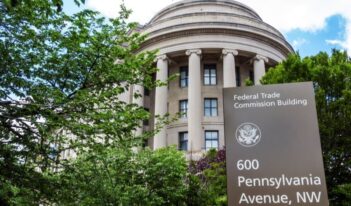
Federal securities regulators should not use implied preclusion to shield themselves from constitutional challenge.
Can the U.S. Securities and Exchange Commission (SEC) unilaterally deny citizens the right to challenge the constitutionality of its administrative hearings in federal court?
The SEC has argued that bringing enforcement actions against entities in-house prevents the federal district courts from hearing constitutional challenges to its adjudication process. In other words, the SEC believes that when it initiates an enforcement action against a business or an individual, the entity cannot sue the agency in federal court. Instead, the entity must raise challenges to the agency’s adjudicatory structure with the agency first and then again during the appeal to federal court.
Entities counter that they should not have to endure what they claim is an unconstitutional proceeding before being able to raise their claim in an Article III court, especially when they can never remedy the harms from undergoing such a proceeding. You cannot unscramble an egg!
Other agencies, such as the U.S. Federal Trade Commission, have made identical arguments.
This issue raises a fundamental question. Who should resolve challenges about an agency’s constitutionality: the federal courts or the adjudicating agency? Although the SEC argues that it should resolve these challenges, it is wrong. Federal courts should resolve constitutional challenges to an agency’s adjudicative structure.
The Securities Exchange Act of 1934 as amended by the Securities Enforcement Remedies and Penny Stock Reform Act of 1990 and the Dodd-Frank Wall Street Reform and Consumer Protection Act of 2010 gave the SEC the power to choose its forum for enforcement actions: an adjudication before an SEC administrative law judge (ALJ) or a civil suit in federal court before an Article III judge.
After the SEC lost numerous high-profile cases in federal court, the SEC switched tactics, bringing its claims in-house in front of its ALJs. In response, the entities sought to avoid the SEC’s adjudicative process. Losing before the SEC would effectively end their careers because the appellate court does not automatically grant a stay of the SEC’s orders—that is, pausing their legal effect—during appeals to federal court. And the SEC typically denies stay requests.
In response to the SEC moving in-house, the entities, now plaintiffs, sued in federal district courts around the country to challenge the constitutionality of the SEC’s in-house process. Their constitutional claims have included unlawful delegation, violation of equal protection and due process, interference with the right to a jury trial, and unconstitutional appointment and removal structures for the SEC’s ALJs.
The SEC has responded by arguing that the federal courts lack subject matter jurisdiction to hear the claims, citing the doctrine of implied preclusion. Pursuant to the Administrative Procedure Act (APA), courts may review final agency action except to the extent that the agency’s enabling act precludes judicial review. Preclusion is a narrow doctrine because it runs counter to the U.S. Supreme Court’s longstanding “strong presumption” favoring judicial review of administrative action.
The Supreme Court developed a two-step approach to determine whether Congress intended to preclude judicial review. Courts must first examine the relevant statute’s text, structure, and purpose to see if Congress intended to preclude judicial review. This step—articulated in Block v. Community Nutrition Institute—calls on courts to determine whether Congress’s intent is “fairly discernible.”
If it is, then courts must undergo a second step and determine whether the plaintiff’s claim can be meaningfully reviewed during the administrative appeal process. Under this second step—articulated in Thunder Basin Coal Company v. Reich—a court asks whether (1) meaningful judicial review would be unavailable if the district court could not hear the claim, (2) the claim is wholly collateral to the issues raised in the adjudication, and (3) the claims are outside the agency’s expertise.
The Supreme Court has been unclear about the relationship among these three questions, including whether they function as factors that courts must balance or elements that must each be met for the claim to be precluded. But treating them as elements better aligns with the Court’s strong presumption in favor of judicial review.
When the plaintiffs’ lawsuits challenging the constitutionality of the SEC’s adjudicatory process have reached the appellate courts, they have been almost uniform in siding with the SEC. But they have had difficulty applying the two-step approach correctly. To be fair, the Supreme Court developed this approach incrementally over forty years, and it is anything but clear.
So it is of little surprise that the appellate courts have struggled with the analysis. For example, in Bebo v. SEC, the Seventh Circuit analyzed only Thunder Basin’s meaningful review step and only one of the three questions. The Second Circuit in Tilton v. SEC treated Thunder Basin’s three questions as factors, not elements, acknowledging that one question “leaned” in the plaintiffs’ favor. And the D.C. Circuit in Jarkesy v. SEC reversed the burden of proof, stating that the plaintiff must demonstrate “a strong countervailing rationale” against implied preclusion.
Besides misanalyzing the issue, the appellate courts have labored to resolve the litigation in the SEC’s favor. At times, their reasoning has been almost nonsensical.
In Tilton v. SEC, for example, the SEC analyzed the first question—whether meaningful judicial review would be unavailable if the district court could not hear the claim—and reasoned that judicial review was meaningful because it was available, regardless of whether it remedied the harm. Similarly, the Fourth Circuit in Bennett v. SEC analyzed the second question—whether the claim was wholly collateral to the issues raised in the administrative action—and held that the plaintiff’s claims were not wholly collateral because they only arose when the SEC brought the enforcement action. And, the Eleventh Circuit in Hill v. SEC analyzed the third question—whether the claims were outside the agency’s expertise—and strangely concluded that because the claim in that case might be rendered moot and the agency’s expertise would then be unneeded, the “factor” was met.
I could go on.
The appellate courts should have held, however, that the plaintiffs’ constitutional claims were not impliedly precluded. Even assuming the text, structure, and purpose of the Exchange Act evinced congressional intent to preclude review—which it does not—a court must apply Thunder Basin’s meaningful review step to confirm that Congress intended for agencies, and not courts, to resolve these claims.
And regardless of whether a factors-based or elements-based approach to the meaningful review step applies, there can be no meaningful review.
For the first question, meaningful judicial review of these claims is unavailable for many reasons. Plaintiffs may not be able to raise a claim effectively in the administrative forum or put together a sufficient record given that discovery is largely unavailable. Moreover, ALJs and the agency are unlikely to be neutral on these constitutional issues. In addition, plaintiffs may not be able to appeal to a federal court given that the case might settle or the plaintiff might win. Finally, even if plaintiffs could effectively bring a claim before a neutral decisionmaker, the plaintiff’s harm could never be effectively remedied because the plaintiff would have already suffered the harm of undergoing an unconstitutional hearing.
With respect to the second question, the plaintiff’s claim that the hearing process is unconstitutional is unrelated to the SEC’s enforcement action alleging that the plaintiff violated the securities laws. Courts, not agencies, should hear claims that are completely unrelated to, or wholly collateral to, the issues in the enforcement proceeding.
As for the third question, the claims are outside the agency’s expertise. The plaintiff’s claims are “standard questions of administrative law” best left to judicial resolution, as the Supreme Court said in Free Enterprise Fund v. Public Company Accounting Oversight Board. The SEC has no expertise interpreting the U.S. Constitution. Under an elements-based approach, this finding alone is sufficient to conclude Congress did not intend to preclude review. Under a factors-based approach, the outcome is the same. None of the factors show that Congress intended to preclude review.
Importantly, the SEC should not have the power to decide its own constitutionality. Yet the SEC is using the implied preclusion doctrine to shield itself from valid claims challenging its structural legitimacy. Federal courts should hear challenges to the legitimacy of the SEC’s adjudication process. Plaintiffs should not be dragged through years of litigation at the SEC before an Article III court can resolve their constitutional claims. Such an approach almost guarantees that federal courts will never hear these claims.
Almost. After seven years of fighting on this issue, one plaintiff will have her day in the Supreme Court in November. The Court has granted a petition to review the Fifth Circuit’s decision in Cochran v. SEC, a case that squarely presents the implied preclusion question. By next June, I hope the Supreme Court will agree that the SEC has been wrong about implied preclusion.




